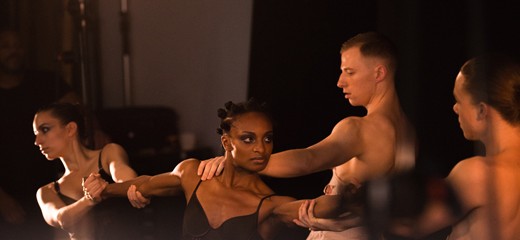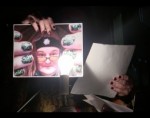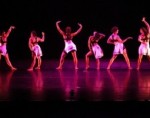
Dance as Palimpsest: Petronio Unplugged
by Lauren Samblanet
1.
I have only encountered Stephen Petronio once before Petronio Unplugged at the Christ Church Neighborhood House. I became acquainted with him through text, through his memoir, Confessions of a Motion Addict. I had selected the book to read for no reason other than the smooth texture of its cover.
I read the memoir in two days, and post-read, I looked up videos of his company online. I had fallen for him – his love for fashion and his honesty charmed me.
2.
MiddleSexGorge (1990) is a dance set in time. Created in response to the AIDS crisis, the politics of the dance are forefront. How can dance be a protest? How can we take control of our bodies? How can we demand someone else help our bodies?
3.
Fists. Clenched fists and wide, stomping, sexy legs.
The choreography reminds me of bodies painted by Keith Haring. But these bodies are so much more powerful. They are not just outlines. These bodies are filled in, are made full by their interactions with one another. They hold one another, sometimes briefly and sometimes for longer. They lift one another and lean against each other. Then, they push away. They take control and control is taken from them.
4.
At Petronio Unplugged, I am disappointed by the lack of costumes, but still, Petronio’s honesty charms me.
5.
It’s not just the dance that feels set in time – Petronio’s chosen title for the evening reminds me of a time I was too young to remember but since then I have been exposed to its cultural artifacts. The MTV Unplugged CDs my parents played on road trips. The 80s music my aunt played for me as we danced around the living room when I was a child. Sitting in the audience, I feel like I’ve been put into Bill and Ted’s time machine phone booth and am now in the late 80s.
Then MiddleSexGorge starts. After a few minutes, I leave the 80s and arrive at Pulse Nightclub.
6.
I have to keep reminding myself that this dance is not about Pulse, that this sexual movement, that these men and women holding each other, that these clenched fists are in response to AIDS. But the song choice, Wire’s “Ambitious Plus,” and the dancers’ thrusting movements, remind me of people enjoying themselves on a weekend night at a club. I find myself thinking about Pulse – about bodies moving in a club, about bodies dying in a club.
I think about my LGBTQIA friends who have had such a wonderful effect on my life. I think about our safe spaces becoming unsafe, about bodies that are already so aware of threat becoming further threatened.
Is it wrong of me, an audience member, to try to find political meaning in the dance outside of the framework that Petronio presents?
7.
Petronio answers an audience question. He discusses how the choreography of a piece changes based on the bodies of the dancers performing it, but says he still sees the original dancers in his mind.
Do all dances become palimpsests over time? Overlaid meanings and overlaid bodies – layers upon layers of old and new, which we, the audience, can never see fully.
What happens to the politics of a dance as that dance moves through time?
Is the original meaning still retained as the dance is performed over decades? If so, how do dancers born after the AIDS crisis respect the original political meaning of MiddleSexGorge and what new politics do they add to it? Is there room for something new in a dance so set in time?
8.
What is most affective about the dancers is the lack of emotion on their faces. A dance about AIDS could easily fall into the trap of sad facial expressions, of spoon-fed emotional narratives. But the dancers avoid the trap.
I find the emotion missing from their faces in the movement of their legs, which are out wide, like yoga’s Goddess Pose. But somehow, as the dancers squat low, bent at the knee, they still move swiftly – as if even while hard at work, they are strong enough to dance even more powerfully than the moment before.
Never have someone’s legs moved me like this.
9.
In thinking of the dance as palimpsest, I cannot help but think of the idea of “an aesthetic of the supplement.” In their book, Art Since 1900: Modernism, Antimodernism, Postmodernism, the authors write of this concept in relation to Robert Morris’ Card File: “…the supplement system appears through the written record of all the chance encounters that entered the process of production and opened it up to an economic, social, biographical, historical system that, in all its randomness and even in its triviality…is not extrinsic to the aesthetic object but indeed necessary to it. In this, the resultant work is unimportant compared with the complexity with which its process of making intertwines with a variety of ‘external’ structures” (Foster, et al 573).
The supplement of MiddleSexGorge is Petronio stating what the dance is about before the dance begins. We learn biographical, social, historical information about the dance that feels necessary to our understanding of what we will see.
What happens to the viewer who doesn’t have the supplement to MiddleSexGorge? Are the powerful, stomping legs and tightly clenched fists of the dancers still affective? Would this viewer have known the dance was in response to AIDS?
10.
I keep thinking about layers, the layers of any work of art. There is the work, itself. There is the audience. In dance, there are also the dancers. Then the context, which is sometimes a supplement and sometimes spoken and sometimes written. Perhaps another layer is added when the artist / choreographer is interviewed. There is a layer added by time – how the piece is altered by new world events.
Is it true that a work of art can never be viewed in the same way twice?
11.
Petronio speaks before MiddleSexGorge about creating a dance language, “Petronio language.” I find myself thinking of bee “theorists” who discuss bees as having an entire language of dance, in which their movements are the signifier and the information they convey, such as a food source, is the signified. Perhaps for dancers, the notion of dance language is nothing new, but for me, this opens up a world of possibility. What does my body, as I dance in a club, tell those that dance beside me?
12.
My memories bring new layers to the dance. My memories also cover up other layers of the dance.
13.
During the performance, after I’ve thought about Pulse, I remind myself that this is about AIDS. I try to think about the dance solely through that lens – to forget Pulse.
I think about Kevin Killian’s poetry collection, Argento Series, which was also written in response to the AIDS crisis. Strangely, like Petronio’s MiddleSexGorge, what is most affective about Killian’s book is not what I expect. The back cover of the book is a list chronicling events and deaths beginning in 1979 and ending with, “1994 FDA approves wide range protease inhibitors, 1997 death of Kathy Acker, ‘I saw something important I can’t remember’” (Killian).
How blurry time becomes when marked with so many deaths.
14.
Is a palimpsest always dependent upon an aesthetic of the supplement? Can a work of art with so many layers be successful without supplement?
Am I adding supplement to MiddleSexGorge that doesn’t exist? At what point do my memories, my life, get in the way of meaning?
15.
MiddleSexGorge is about legs as a means of power and legs as a means of sexual contact. It’s about AIDS and protest and control.
MiddleSexGorge has accumulated meaning as it has moved through time. I don’t know if any of its original meaning was lost, but I know it has found new meaning. It is more layered. Its supplement might remain the same, but I can see something in it beneath the surface. Bodies upon bodies. Legs upon legs. Fists upon fists. What else has been overlaid and what am I not seeing?
16.
The dancers hold one another. But after this holding, dancers leave the stage. One dancer is left behind – they dance a solo, until again, other dancers return and ask to be held or ask to hold. But they always disappear again, leaving one dancer alone.
This ebb and flow of one versus several dancers on stage makes me think of ignored bodies in need that end up disappearing. Of time becoming blurry because it’s marked with so many deaths. Of meaning becoming blurry because a work has become so layered, so thick with supplement.
Through all the layers, I’m left with the feeling that I saw something beneath the surface, “something important I can’t remember.”
Petronio Unplugged: A Selection of Repertory Stripped Down and Up Close, Stephen Petronio Company, June 21, Christ Church Neighborhood House, http://www.neighborhood-house.com/
MiddleSexGorge performed by: Davalois Fearon, Kyle Filley, Gino Grenek, Jaqlin Medlock, Tess Montoya, Nicholas Sciscione, Emily Stone, and Joshua Tuason
Sources: Foster, Hal, Rosalind Krauss, Yve-Alain Bois, Benjamin H.D. Buchloh, and David Joselit. “1968b.” Art Since 1900: Modernism, Antimodernism, Postmodernism. Ed. 2. New York: Thames and Hudson, 2004. Print.
Killian, Kevin. Argento Series. San Francisco: Krupskaya, 2002. Print.
By Lauren Samblanet
July 9, 2016








